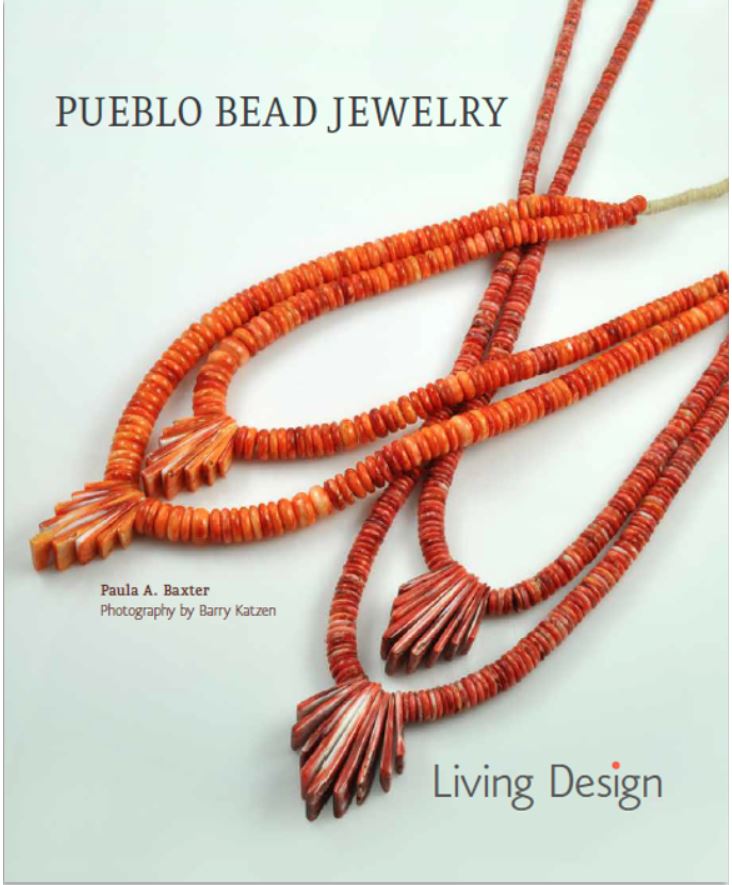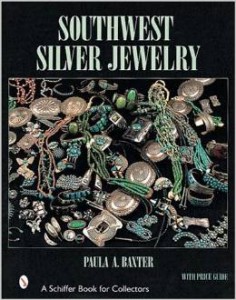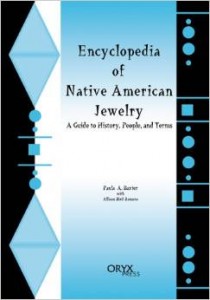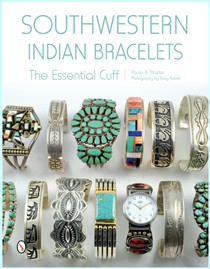Backing is the material that is placed behind set-in stonework in jewelry. Native backing varies from that employed by non-Native jewelers. While most jewelers work with black epoxy applied to settings to strength thin stones, many lapidaries cut their stones thicker and so don’t require conventional backing.
Fact: Vintage era Native jewelers have improvised with found materials like sawdust, cardboard, and paper (from thin tissue to newspaper) as backing in order to level stones, often because they couldn’t afford commercial backing materials.
What has made the Indian arts market so wonderful over the past seventy years is that you could find good work in every price range, especially so with jewelry. Good quality Indian jewelry could be had at high quality costume jewelry prices, and as collectors developed their desires, they spent more if they believed in the artist and his/her aesthetic creativity. If prices show a disconnect between good design and materials, the buyer’s faith becomes eroded. At the same time, most collectors understand that materials costs and scarcity will affect prices, and they may have to pay a little more. Nevertheless, let’s be blunt: most arts, Indian or otherwise, are luxury goods. The makers of mainstream luxury goods like Vuitton and Prada can afford to raise their prices every year because their market will always have deep pockets. Can most Indian artists claim the same about all their customers?
That’s a problem right there. Indian artists have endured too many years of competing with schlock souvenir goods that too many people see and think are legitimate. The years of discount sales, ones that still go on today at selected locations, have eroded buyer trust. When you bring those people who collect Indian arts but aren’t personally wealthy (like yours truly) to Indian Market, they aren’t looking for a bargain, but they are looking for something they can spend their money on with pride and pleasure. Why should those who can afford high end arts be the only ones who can count on getting value for their money? Collectors are better educated than they used to be.
(Part 3 of a series)
 Santa Fe Cathedral during Indian Market
Santa Fe Cathedral during Indian Market
Those who want to buy have had their enthusiasm strangled on two fronts:
- First, there are still too many eyewitness accounts of suspect materials appearing in jewelry; SWAIA has strict standards about this, and while I believe they are upholding them as best they can, it’s analogous to the situation where cops can’t catch and ticket all the texting/cell chatting drivers.
- Second, many artists are pricing their works too high. Yes, materials costs have gone up, but in an era where money is an issue again, only the very high-end artists can maintain their prices.
Maybe it’s time someone out in the Southwest organized a town hall or forum that addresses the realities of pricing. I worry that too many people think they entitled to getting higher prices right away, when time has shown that artist reputations are earned and not created overnight. Superstars like Cody Sanderson and Pat Pruitt put in a lot of time selling at reasonable prices to build a reputation for good quality designs.
(Part 2 of a series)
Reports have been coming in about this past SWAIA Indian Market in Santa Fe. Attendance was down and sales were fairly quiet. Some artists felt their sales either stayed the same as last year or were slightly reduced. Collectors reported that they generally felt that there were more mediocre arts on offer, and that designs and materials weren’t as innovative or satisfactory as they have been. Lots of people on either side of the booths claimed that prices were too high.
Santa Fe’s Indian Market was created in the early 1920s as a means of boosting Native earnings and enticing more people into collecting Native arts. SWAIA has had various ups and downs as manager of this important market. I don’t think they should take any blame for the recent disappointments of the markets—the economy is still a damper. However, two issues have emerged over the past few years.
(Part 1 of a series)
Concho belts as we know them — small to huge discs of silver shaped and stamped and made to link together — are becoming fairly rare adornment. Conchos made in the early decades of Southwestern Indian silversmithing are now immensely valuable objects. The best examples appear in museum displays or are hidden in bank vaults. A certain kind of fashionable concho belt shows up on Fashion Week runways and artsy fashion magazine spreads. An even more sketchy type lives in in contemporary western wear.
Indian arts dealers will tell you that these items, originally derived from Spanish and Mexican horse and bridle gear, are hard to sell. Forgeries do abound. Theories about this phenomenon also proliferate. The best concho belts are relatively heavy to wear. What everyone does agree, however, is that when someone models a genuine article that person has made an irrefutable fashion statement!
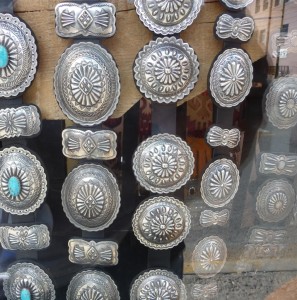 Window display of concho belts, Santa Fe.
Window display of concho belts, Santa Fe.
The other day I got a book out of the library at the college where I work. Catherine C. Robbins wrote All Indians Do Not Live in Teepees (or Casinos) (University of Nebraska Press, 2011) based on many years of journalistic pursuits in the Southwest. Her stories from Indian Country cover a wide range of topics and issues. One of my favorite chapters, however, concerns the Indian artist’s frustration with the “buckskin ceiling” applied to Native art-making. Sometimes this ceiling is also a box: one in which non-Native expectations of how Indian art should look remain “pickled” in the past. Native artists have been rolling their eyes about this problem since the 1960s.
When I write about Indian jewelry, I work hard to make it clear that labels used for certain jewelry forms have come from outsiders. What is traditional seems silly when one looks at Southwestern Indian metal jewelry-making. Unlike in Mesoamerica, Natives of the American Southwest did not acquire the process of metallurgy until its colonial era when Mexican and then European American settlers (many of them soldiers) taught them the craft.
We will be taking in the festivities that lead up to the Heard Museum Guild Indian Fair and Market on March 3-4.
Prior to that, I will be signing copies of Southwestern Indian Rings during the Scottsdale Art Walk on March 1. I am dividing my time between two locations:
Old Territorial Indian Arts at 7077 E Main St, from 5 to 7 p.m.
Waddell Trading Company at 7144 East Main Street, from 7 p.m. to 9 p.m.
These two shops are among my favorite destinations in Arizona, and they represent two aspects of the fine Indian art to be found in Scottsdale:
Old Territorial is the oldest running Indian arts shop in the Valley of the Sun. Alston and Deborah Neal offer vintage and contemporary Indian arts that reflect the sturdiness of traditional Native design.
Waddell Trading Company contains dazzling works in rich materials by some of the very best contemporary artists working today. You will see pieces that offer a virtuoso twist on the traditional or avant-garde items that foretell the directions Native style will take.
While we have come a long way societally since the first half of the twentieth century, many people still have outdated or unrealistic notions about how American Indians live and think. Part of the problem is that Indians are a genuine minority, representing just under 1% of the American population. Unless one lives close to an Indian reservation, this ethnic group often fails to register in the collective consciousness of our popular culture. Nor do we have television programs, major movies (other than westerns), or celebrities who represent our indigenous peoples. Another large problem has to do with our educational system. American Indians figure in many secondary students’ social studies curricula; usually, this examination looks back to older times and features Indians in clothing and situations that belong to the nineteenth century. No wonder many people, including Europeans, come to Indian Country with rather fantastic expectations. They want buckskin and feathers when they should look for denim and cellphones.
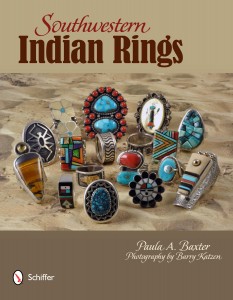 Southwestern Indian Rings
Southwestern Indian Rings
by Paula A. Baxter
Photography by Barry Katzen
Visit Amazon for its discounted price
With a fascinating variety of American Indian rings from the southwestern United States shown in more than 360 color photos, Southwestern Indian Rings
provides a design history of these rings, beginning with pre-contact artifacts and continuing through to contemporary artistic innovations.
The text surveys key developments in Native American ring design; materials and methods of construction; definitions for historical and vintage rings; master innovators; and the transition from craft to wearable art since 1980.
Shortly after the Civil War, Native American artisans began making silver rings set with turquoise, coral, jet, mother-of-pearl, and colored shell, adding lapis, malachite, onyx, and petrified wood over the decades. More recently, artisans began utilizing gold and such non-traditional settings as opals and diamonds, among others.
Works by Navajo and Pueblo artists are featured, although Apache, Northern Cheyenne, and Sonoran Desert Native jewelers are also included. A guide to valuation issues and resources is offered for collectors.
978-0-7643-3875-5
hardcover $34.99 (but Amazon is giving a discount)
8 1/2 x 11
160 pages
361 color photos
